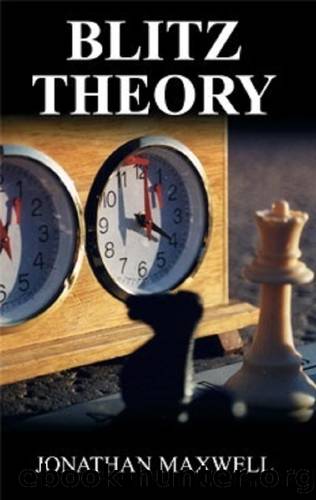Blitz Theory: How To Win At Blitz Chess by Jonathan Maxwell & Walter Browne

Author:Jonathan Maxwell & Walter Browne [Maxwell, Jonathan]
Language: eng
Format: mobi
Publisher: Silent Lyric Productions, Inc.
Published: 2020-11-14T00:00:00+00:00
âAgainst 1.d4
âFirstly, it should be stated that the foe in front of us is probably of a positional breed as he opts for the safe and sound queen's pawn thrust; therefore, we can immediately take solace in the fact that after we muscle the opening to familiar grounds, our tactical play will give us an advantage in the ensuing fight.
â1. The Albin Countergambit
âA wonderful blitz enterprise. First, we can enjoy watching our opponent shift in his seat for ten seconds after 2...e5. Then commences the exciting setting of the many different traps depending on how white attempts to quiet our renegade "d" pawn. There is every chance he will be down material by move ten or mated by move twenty. If he isn't, his pawns will be doubled and isolated while his kingside remains critically unemployed and without promise. If he makes it to a middle game with a pulse, then he will only have about half his time left to undertake the daunting task of manifesting his unlikely tactical prowess. All this for a pawn!
â2. The Benko Gambit
âThis is sound and sharp in slow chess. By trading two flank pawns for whiteâs âdâ pawn, we remove his control of the prized real estate at e5 and c5, we gain immediate dominating pressure on the queenâs wing with our heavy pieces, and a menacing bishop at a6. I really donât see how itâs possible to not love this opening.
â3. The Englund Gambit
âWhile I wouldn't advocate this in a six hour game, it fits blitz conditions like a glove. Firstly, it scores the maximum on surprise value as our adversary may never have seen the response 1...e5 in his life. Secondly, the anomalic queen and knight sorties on the queenside will hemorrhage seconds off his clock.
â4. The Benoni Defense
âThis is a perfect cap to our black arsenal against 1.d4. Tactical and uncompromising, it is a fine call to our job description. Upon seeing 2...c5, our opponent will no doubt begin to wonder what happened to his happier days of quiet maneuvering for modest holes and backward pawns.
â5. Straightforward development against uninspired play
âIf white decides to relinquish the advantage of his first move with something anemic such as 2.e3, or 2.g3, then we can consider our job done. Classical expansion will be sufficient for a good game.
Download
This site does not store any files on its server. We only index and link to content provided by other sites. Please contact the content providers to delete copyright contents if any and email us, we'll remove relevant links or contents immediately.
| Coloring Books for Grown-Ups | Humor |
| Movies | Performing Arts |
| Pop Culture | Puzzles & Games |
| Radio | Sheet Music & Scores |
| Television | Trivia & Fun Facts |
The Infinite Retina by Robert Scoble Irena Cronin(6220)
Harry Potter and the Cursed Child: The Journey by Harry Potter Theatrical Productions(4471)
The Sports Rules Book by Human Kinetics(4348)
Molly's Game: From Hollywood's Elite to Wall Street's Billionaire Boys Club, My High-Stakes Adventure in the World of Underground Poker by Molly Bloom(3512)
A Knight of the Seven Kingdoms by George R R Martin(3225)
Quidditch Through the Ages by J.K. Rowling(3084)
How To by Randall Munroe(3078)
Flowers For Algernon by Daniel Keyes(3054)
Quidditch Through the Ages by J K Rowling & Kennilworthy Whisp(2949)
Stacked Decks by The Rotenberg Collection(2846)
Quidditch Through the Ages by Kennilworthy Whisp by J.K. Rowling(2831)
Quidditch through the Ages by J. K. Rowling(2782)
Quidditch Through The Ages by J. K. Rowling(2746)
776 Stupidest Things Ever Said by Ross Petras(2745)
What If?: Serious Scientific Answers to Absurd Hypothetical Questions by Randall Munroe(2675)
Ready Player One: A Novel by Ernest Cline(2674)
Beautiful Oblivion by Jamie McGuire(2587)
The Book of Questions: Revised and Updated by Gregory Stock Ph.d(2544)
Champions of Illusion by Susana Martinez-Conde & Stephen Macknik(2436)
